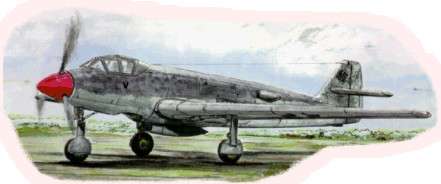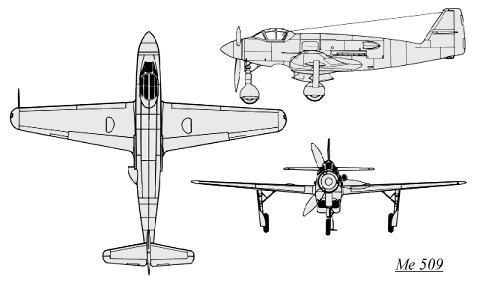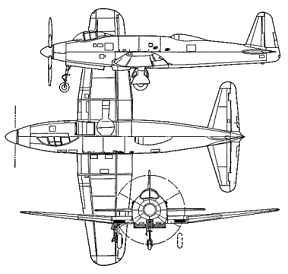
 Although the Me 509 can trace its roots back to the Me 309, very little
information has survived. The aircraft was to be of an all-metal construction.
A new fuselage was designed, with the pressurized cockpit being moved well
forward near the nose. The Daimler Benz 605B 12-cylinder engine was
buried in the fuselage behind the cockpit, and drove a three-bladed, Me
P 6 reversible-pitch propeller by an extension shaft which passed beneath
the cockpit (similar to the US Bell P-39). The wing was tapered and
had rounded wingtips, and was mounted low on the fuselage. Other
Me 309 components were to be used, such as the tricycle landing gear, and
the vertical tail assembly was similar to the one used for the Me 309 V1.
Armament was not decided upon for the 509, but it is thought that two MG
131 13mm machine guns and two MG 151 20mm cannon were to be used. Although
there were advantages of better cockpit visibility and relocation of the
engine weight from the nose gear (important, since the Me 309's nose gear
often collapsed), the Me 509 design and development was stopped when the
Me 309 program was ended in mid-1943.
Although the Me 509 can trace its roots back to the Me 309, very little
information has survived. The aircraft was to be of an all-metal construction.
A new fuselage was designed, with the pressurized cockpit being moved well
forward near the nose. The Daimler Benz 605B 12-cylinder engine was
buried in the fuselage behind the cockpit, and drove a three-bladed, Me
P 6 reversible-pitch propeller by an extension shaft which passed beneath
the cockpit (similar to the US Bell P-39). The wing was tapered and
had rounded wingtips, and was mounted low on the fuselage. Other
Me 309 components were to be used, such as the tricycle landing gear, and
the vertical tail assembly was similar to the one used for the Me 309 V1.
Armament was not decided upon for the 509, but it is thought that two MG
131 13mm machine guns and two MG 151 20mm cannon were to be used. Although
there were advantages of better cockpit visibility and relocation of the
engine weight from the nose gear (important, since the Me 309's nose gear
often collapsed), the Me 509 design and development was stopped when the
Me 309 program was ended in mid-1943.
| Span | Length | Height |
| 11.27 m
37' 0" |
9.94 m
32' 7" |
3.98 m
13' 1" |
| Manufacturer | Scale | Material | Notes |
| RS Models #7238 | 1/72 | resin, white metal & decals | includes instrument panel decal |
| Wingnut International | 1/72 | resin | very fine cast kit, almost injection quality |

Left: The Yokosuka R2Y
Keiun, which was built for the Japanese Navy use, was an aircraft
very similar in design to the Messerschmitt Me 509. Its first flight was
in May 8, 1945, and was cut short due to engine overheating, a problem
that probably would have also faced the Me 509.
